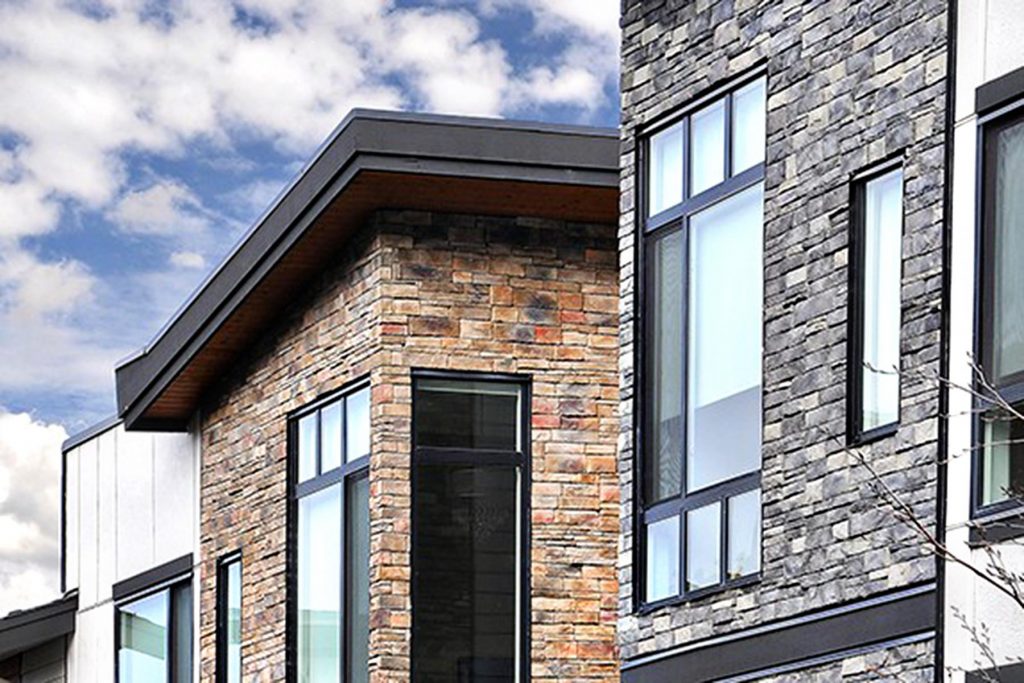 Stone veneers add character and elegance to our homes. They also enhance a house’s overall desirability, thereby increasing its property value. We also appreciate them for their versatility. Veneers can be installed onto fireplaces, accent walls, garden walls, driveways, columns and other sections inside and outside our homes. Furthermore, you can install them to add sophistication to brightly coloured rooms or for a pop of colour and texture in neutral palettes.
Stone veneers add character and elegance to our homes. They also enhance a house’s overall desirability, thereby increasing its property value. We also appreciate them for their versatility. Veneers can be installed onto fireplaces, accent walls, garden walls, driveways, columns and other sections inside and outside our homes. Furthermore, you can install them to add sophistication to brightly coloured rooms or for a pop of colour and texture in neutral palettes.
Perhaps you enjoy having brick walls, but you’d like to switch things up. Stone veneers can be a great choice if you want to add a modern twist while maintaining the rustic look of your home. However, you might wonder if you can install stone veneer without removing any of the existing brick facades. It is absolutely possible. Below, we’ll discuss the steps you need to follow to do it well.
Get Your Tools
Installing stone veneers over bricks can be an exciting project for DIYers and professionals alike. However, you’ll not be able to produce quality work without the right equipment. You’ll need tools such as a ½-inch notched trowel, a margin trowel, nails, a hammer, buckets, masonry fasteners, a drill, a tape measure, levels and a chalk line.
Use a Scratch Coat
Next, you’ll need to ensure that the brick surfaces are porous so that they can accept your scratch coat. A scratch coat consists of cement and sand (mortar) that glues the stone veneer to the brick. While it is an effective adhesive, a scratch coat will not work on painted, smooth or crumbly bricks. Painted and smooth bricks aren’t porous enough, while crumbly bricks don’t have sufficient structural integrity to support the scratch coat. Fortunately, you can correct these issues by sandblasting or power washing the paint, oils or dirt.
You may also want to consider applying corrosive-free metal lath to the bricks with masonry fasteners. This method requires that the cups point upwards, and it also includes horizontal and vertical slats to maintain the framework.
Once you’ve achieved a compliant surface – whether you’ve fixed the bricks or are using metal lath – you are ready to trowel the scratch coat. While you’re at it, provide adequate support for the stone veneer by ensuring that all gaps and holes are covered.
Consider Cement Board
As an alternative to the methods mentioned above, cement boards are perfect for amateurs or anyone looking to complete the project at a fast pace. You can simply install them over the bricks, then add the stone veneer.
Cement boards are already flat and hard, so there is no need to use a trowel to flatten them. Unlike with a scratch coat, you won’t need to wait until the surface is dry, so you can start applying the stone veneer right away.
To get started, you’ll need to add an adhesive to the board and nail it to the brick wall. This creates an instant layer that bridges over the bricks’ cracks, gaps and any other flaws. Then, you’ll add a layer of mortar to the board to allow the stone veneer to stick.
Choose Your Stone Veneer
Stone veneers are available in a variety of designs and patterns. These patterns fall into three main categories: natural, manufactured and faux.
Natural stone veneer is the most realistic in appearance. It is also the most expensive. It is made from real stone quarried from the earth and features beautiful imperfections and elegant textures that take thousands of years to form. They can be quite heavy, but you have the choice of using thin-sliced veneers, which are more workable. The colour variations are rich, and no two pieces look exactly alike.
On the other hand, manufactured stone veneer is made from Portland cement, aggregates and iron oxide. To the untrained eye, it is difficult to tell it apart from natural stone veneer, as it is designed to resemble the real thing. It is lighter than natural stone veneer but heavier than faux stone. You’ll receive them as individual stones, which allows you to apply each to the mortar as you would apply the natural stone veneer.
Faux stone veneer, meanwhile, contains no stone or natural products. It is made of polyurethane and can look quite realistic. They’re the most affordable, and they come in panels rather than individual stones, allowing you to save time during the installation.
Contact Us
Our experienced team at Pacific Art Stone in Surrey, BC, will help you choose a stone veneer that mirrors your personal style and suits your budget whether you are a beginner, amateur or expert. We offer a wide range of natural, manufactured cultured and faux stone veneers that feature a variety of designs, textures and patterns. Call us at (604) 590-5999 today and get started with your project.
